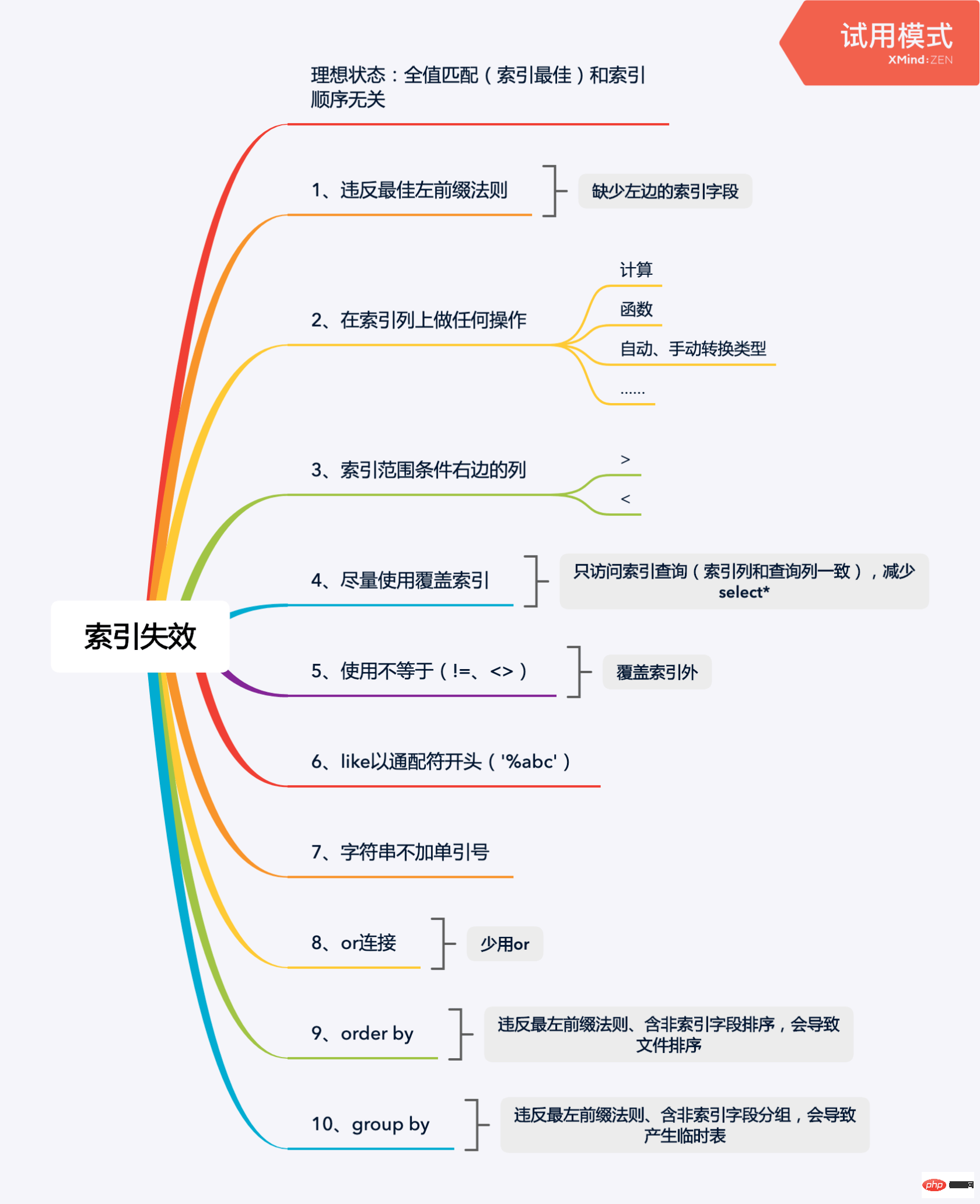explain select * from user where name = 2000;
Introducing the situation of mysql index failure
# mysql video tutorial column index expires.

#Indices are a very important chapter for MySQL. There are also a lot of index knowledge points. If you want to master them thoroughly, you need to break down each knowledge point one by one. Today, let’s first talk about the situations that will cause index failure.
Picture summary version

Related free learning recommendations: mysql video tutorial
Full value matching (best index)
explain select * from user where name = 'zhangsan' and age = 20 and pos = 'cxy' and phone = '18730658760';

和索引顺序无关,MySQL底层的优化器会进行优化,调整索引的顺序 explain select * from user where name = 'zhangsan' and age = 20 and pos = 'cxy' and phone = '18730658760';

如果索引有多列,要遵守最左前缀法则
即查询从索引的最左前列开始并且不跳过索引中的列
explain select * from user where age = 20 and phone = '18730658760' and pos = 'cxy';
Copy after login
如果索引有多列,要遵守最左前缀法则 即查询从索引的最左前列开始并且不跳过索引中的列 explain select * from user where age = 20 and phone = '18730658760' and pos = 'cxy';

如计算、函数、(自动or手动)类型转换等操作,会导致索引失效从而全表扫描
explain select * from user where left(name,5) = 'zhangsan' and age = 20 and phone = '18730658760';
Copy after login
如计算、函数、(自动or手动)类型转换等操作,会导致索引失效从而全表扫描 explain select * from user where left(name,5) = 'zhangsan' and age = 20 and phone = '18730658760';

索引范围条件右边的索引列会失效
explain select * from user where name = 'zhangsan' and age > 20 and pos = 'cxy';
Copy after login
索引范围条件右边的索引列会失效 explain select * from user where name = 'zhangsan' and age > 20 and pos = 'cxy';

只访问索引查询(索引列和查询列一致),减少select*
explain select name,age,pos,phone from user where age = 20;
Copy after login
只访问索引查询(索引列和查询列一致),减少select* explain select name,age,pos,phone from user where age = 20;

mysql在使用不等于(!=、)的时候无法使用索引会导致全表扫描(除覆盖索引外)
explain select * from user where age != 20;
explain select * from user where age 20;
Copy after login
mysql在使用不等于(!=、)的时候无法使用索引会导致全表扫描(除覆盖索引外) explain select * from user where age != 20; explain select * from user where age 20;


索引失效
explain select * from user where name like '%zhangsan';
Copy after login
索引失效 explain select * from user where name like '%zhangsan';

索引生效 explain select * from user where name like 'zhangsan%';

explain select * from user where name = 2000;
Copy after login
explain select * from user where name = 2000;

少用or
explain select * from user where name = '2000' or age = 20 or pos ='cxy';
Copy after login
少用or explain select * from user where name = '2000' or age = 20 or pos ='cxy';

正常(索引参与了排序)
explain select * from user where name = 'zhangsan' and age = 20 order by age,pos;
备注:索引有两个作用:排序和查找
Copy after login
导致额外的文件排序(会降低性能)
explain select name,age from user where name = 'zhangsan' order by pos;//违反最左前缀法则
explain select name,age from user where name = 'zhangsan' order by pos,age;//违反最左前缀法则
explain select * from user where name = 'zhangsan' and age = 20 order by created_time,age;//含非索引字段
Copy after login
正常(索引参与了排序) explain select * from user where name = 'zhangsan' and age = 20 order by age,pos; 备注:索引有两个作用:排序和查找
导致额外的文件排序(会降低性能) explain select name,age from user where name = 'zhangsan' order by pos;//违反最左前缀法则 explain select name,age from user where name = 'zhangsan' order by pos,age;//违反最左前缀法则 explain select * from user where name = 'zhangsan' and age = 20 order by created_time,age;//含非索引字段


 ##10、group by
##10、group by
正常(索引参与了排序) explain select name,age from user where name = 'zhangsan' group by age; 备注:分组之前必排序(排序同order by)
导致产生临时表(会降低性能) explain select name,pos from user where name = 'zhangsan' group by pos;//违反最左前缀法则 explain select name,age from user where name = 'zhangsan' group by pos,age;//违反最左前缀法则 explain select name,age from user where name = 'zhangsan' group by age,created_time;//含非索引字段



##Sample data used
mysql> show create table user \G ****************************************************** Table: user Create Table: CREATE TABLE `user` ( `id` int(10) NOT NULL AUTO_INCREMENT, `name` varchar(20) DEFAULT NULL, `age` int(10) DEFAULT '0', `pos` varchar(30) DEFAULT NULL, `phone` varchar(11) DEFAULT NULL, `created_time` datetime DEFAULT NULL, PRIMARY KEY (`id`), KEY `idx_name_age_pos_phone` (`name`,`age`,`pos`,`phone`) ) ENGINE=InnoDB DEFAULT CHARSET=utf8mb4 COLLATE=utf8mb4_0900_ai_ci
The above is the detailed content of Introducing the situation of mysql index failure. For more information, please follow other related articles on the PHP Chinese website!

Hot AI Tools

Undresser.AI Undress
AI-powered app for creating realistic nude photos

AI Clothes Remover
Online AI tool for removing clothes from photos.

Undress AI Tool
Undress images for free

Clothoff.io
AI clothes remover

Video Face Swap
Swap faces in any video effortlessly with our completely free AI face swap tool!

Hot Article

Hot Tools

Notepad++7.3.1
Easy-to-use and free code editor

SublimeText3 Chinese version
Chinese version, very easy to use

Zend Studio 13.0.1
Powerful PHP integrated development environment

Dreamweaver CS6
Visual web development tools

SublimeText3 Mac version
God-level code editing software (SublimeText3)

Hot Topics
 MySQL's Role: Databases in Web Applications
Apr 17, 2025 am 12:23 AM
MySQL's Role: Databases in Web Applications
Apr 17, 2025 am 12:23 AM
The main role of MySQL in web applications is to store and manage data. 1.MySQL efficiently processes user information, product catalogs, transaction records and other data. 2. Through SQL query, developers can extract information from the database to generate dynamic content. 3.MySQL works based on the client-server model to ensure acceptable query speed.
 How to start mysql by docker
Apr 15, 2025 pm 12:09 PM
How to start mysql by docker
Apr 15, 2025 pm 12:09 PM
The process of starting MySQL in Docker consists of the following steps: Pull the MySQL image to create and start the container, set the root user password, and map the port verification connection Create the database and the user grants all permissions to the database
 Laravel Introduction Example
Apr 18, 2025 pm 12:45 PM
Laravel Introduction Example
Apr 18, 2025 pm 12:45 PM
Laravel is a PHP framework for easy building of web applications. It provides a range of powerful features including: Installation: Install the Laravel CLI globally with Composer and create applications in the project directory. Routing: Define the relationship between the URL and the handler in routes/web.php. View: Create a view in resources/views to render the application's interface. Database Integration: Provides out-of-the-box integration with databases such as MySQL and uses migration to create and modify tables. Model and Controller: The model represents the database entity and the controller processes HTTP requests.
 Solve database connection problem: a practical case of using minii/db library
Apr 18, 2025 am 07:09 AM
Solve database connection problem: a practical case of using minii/db library
Apr 18, 2025 am 07:09 AM
I encountered a tricky problem when developing a small application: the need to quickly integrate a lightweight database operation library. After trying multiple libraries, I found that they either have too much functionality or are not very compatible. Eventually, I found minii/db, a simplified version based on Yii2 that solved my problem perfectly.
 How to install mysql in centos7
Apr 14, 2025 pm 08:30 PM
How to install mysql in centos7
Apr 14, 2025 pm 08:30 PM
The key to installing MySQL elegantly is to add the official MySQL repository. The specific steps are as follows: Download the MySQL official GPG key to prevent phishing attacks. Add MySQL repository file: rpm -Uvh https://dev.mysql.com/get/mysql80-community-release-el7-3.noarch.rpm Update yum repository cache: yum update installation MySQL: yum install mysql-server startup MySQL service: systemctl start mysqld set up booting
 Centos install mysql
Apr 14, 2025 pm 08:09 PM
Centos install mysql
Apr 14, 2025 pm 08:09 PM
Installing MySQL on CentOS involves the following steps: Adding the appropriate MySQL yum source. Execute the yum install mysql-server command to install the MySQL server. Use the mysql_secure_installation command to make security settings, such as setting the root user password. Customize the MySQL configuration file as needed. Tune MySQL parameters and optimize databases for performance.
 Laravel framework installation method
Apr 18, 2025 pm 12:54 PM
Laravel framework installation method
Apr 18, 2025 pm 12:54 PM
Article summary: This article provides detailed step-by-step instructions to guide readers on how to easily install the Laravel framework. Laravel is a powerful PHP framework that speeds up the development process of web applications. This tutorial covers the installation process from system requirements to configuring databases and setting up routing. By following these steps, readers can quickly and efficiently lay a solid foundation for their Laravel project.
 MySQL vs. Other Programming Languages: A Comparison
Apr 19, 2025 am 12:22 AM
MySQL vs. Other Programming Languages: A Comparison
Apr 19, 2025 am 12:22 AM
Compared with other programming languages, MySQL is mainly used to store and manage data, while other languages such as Python, Java, and C are used for logical processing and application development. MySQL is known for its high performance, scalability and cross-platform support, suitable for data management needs, while other languages have advantages in their respective fields such as data analytics, enterprise applications, and system programming.






